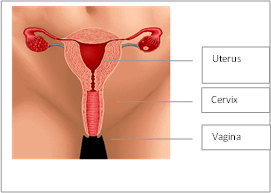Gynaecology |
D3
|
Abnormal Vaginal Bleeding
- Overview
- Could the bleeding be due to cancer?
- What happens in the clinic
- Ultrasound scans
- Gynaecological Examination
- D&C
- Heavy Menstrual bleeding
Overview
The specialist clinic that looks after women with abnormal vaginal bleeding is known as the PMB clinic. This represents the specialist clinic is dedicated to finding out why women have abnormal bleeding, usually when they are post (or peri) menopausal. (PMB+post/peri menopausal bleeding).
Most abnormal uterine bleeding occurs around the time for the menopause for after it but the specialist service will also find out why chaotic or random bleeding is abnormal in younger women. It is not a clinic for heavy regular bleeding as this cared for in the general gynaecology service.
There are many causes for random or chaotic bleeding. Cancer is a rare cause but broadly speaking, most women want to know the cause, know that it is not a cancer and to know their options. Consequently, this clinic is dedicated to excluding (or diagnosing cancer) and getting an explanation for you.
Could the bleeding be due to cancer?
Cancer is rare. Only one in 10 women with significant bleeding after the menopause had a cancer. This means that 90% of women (9 out of 10) don't. Cancer is much rarer in younger women. Abnormal (random) bleeding is an important sign.
The uterus is designed to bleed and bleeding can be the sign of a very early uterine cancer. Cure rates are very high if a woman asks her doctor to check on the cause of abnormal bleeding when symptom first start. The vast majority of women don't not have cancer and benefit from knowing the cause.
What happens in the clinic?
You attend the clinic after your General Practitioner has decided you need investigations for abnormal vaginal bleeding. They contact the RUH and you will normally be sent an appointment within a fortnight. We try and sent you a form to complete and hand in once you come to the clinic.
Sometimes, there is no waiting time and we may phone you with an opportunity to come within the week. As the post may take longer than the wait for the appointment, you may not get a letter.
The clinic has every facility to find out where abnormal bleeding is coming from. The main tests are:
Doing all the tests at one visit
Most women prefer to have everything sorted out at one visit but obviously we would be keen to do whatever suits you and be guided by your particular request.
If you did feel that you might like to have an examination, it is worth pointing out that any internal examination is undignified and uncomfortable but it not usually painful. It only lasts for a minute or so.
Some women like to take a few Aspirins or their favourite anti-inflammatory pain killer beforehand. This is probably unnecessary because the gynaecologist isn't going to continue if you find it examination distressing, but some women like the reassurance having taken some pain relief.
The web page is simply designed to give you an idea of what is available if you choose to use the service. The main reason for you coming to the clinic is to talk about what is there and what your options are.
Ultrasound scans

The female reproductive organs
A useful test for women who have finished their periods is to scan the uterus. Ultrasound scanning is a simple and completely painless technique and uses sound waves to produce a picture. It uses the same principle that battle ships use when bouncing sound waves of submarines in wartime.
Obviously modern medical ultrasound equipment is far more sophisticated and gets much better quality pictures.
Jelly is placed over the lower part of your abdomen and we look at the uterus. It is useful if your bladder is full, it allows the sound waves to pass through the water and this improves the quality of the pictures.
Sometimes the probe on the abdomen doesn't get pictures with sufficient quality and an easy way to get close to the uterus is to place the sensor just in the entrance of the vagina. It doesn't go all the way into the vagina, it sits just between the lips of the entrance.
Sometimes we organise for you to have a scan before you are seen by the gynaecologist. This is so that as much information is available as possible for the consultation and it is designed to save you time.
Although it may be efficient to get it all done in one visit, it does make it a long visit. If you do need a scan, you may prefer to be scanned via the vagina because the quality of the image can be better and you don't have to have a full bladder.
Gynaecological Examination
The scan can provide lots of useful information but it can't see the skin of the cervix and uterus (the womb). To view this, a gynaecologist would need to talk to you about your symptoms. You can choose to be examined at this consult. If your GP has not already checked your cervix, we would look at the cervix in the same way as we do a smear.
It is also possible to look inside the uterus to see if there is any cause for the bleeding in the uterine cavity.
A very useful technique is to pass a very fine soft plastic device into the uterus and this samples the cells from the cavity of the uterus. These cells can be processed and examined in the laboratory.
Processing can take several weeks but it does provide a very useful assessment of the cause of any bleeding.
You may choose to have cells sampled at this visit. Alternatively, you may prefer not to be examined and prefer to have an anaesthetic.
Most people prefer to avoid an anaesthetic and all the inconveniences that go with it, but there are times when it is simply impossible to get a good examination inside of the uterus to thoroughly check what is going on.
D&C
The D stands for dilatation, which means opening the mouth of the womb a little. C stands for curettage. Curettage means that the thin covering of the inside of the womb is gently removed using a small scrapper.
The tissue is then sent to the laboratory to be checked. The test is usually combined with a telescope examination of the inside of the uterus. This is called a hysteroscopy.
These tests can be painful for some women and you can choose an anaesthetic. However, many women, particularly if they have delivered a baby vaginally, find that there cervix has no nerves and the procedure is painless.
Your gynaecologist can usually tell if it will be best do check the womb under an anaesthetic


